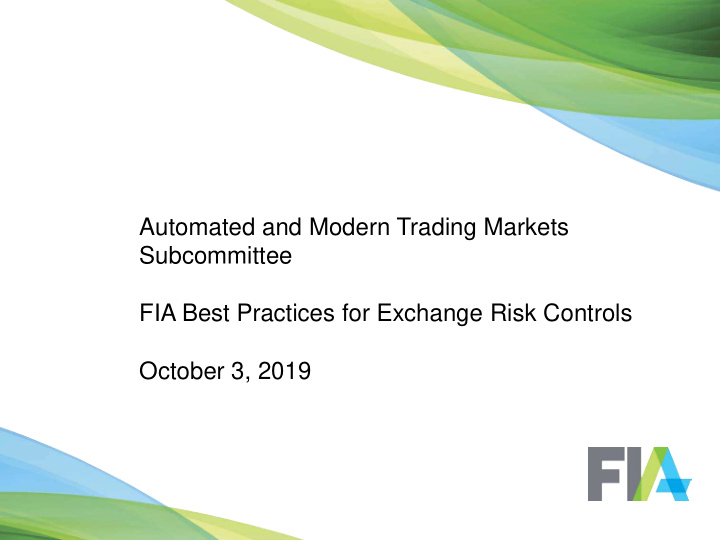



Automated and Modern Trading Markets Subcommittee FIA Best Practices for Exchange Risk Controls October 3, 2019
FIA Best Practices for Exchange Risk Controls Electronic trading has become an integral tool for an increasingly large percentage of market participants; the principles referenced here should apply to both manual and automated trading. The speed, efficiency, and ease of electronic trading has made it attractive to the full spectrum of organizations and individuals that interact with our markets, including principal traders, banks, asset managers, pension funds, commercial hedgers and retail investors. The widespread adoption of electronic trading, including automated trading systems, has provided a range of benefits (i.e. liquidity and tighter spreads), but it has also created the need to update risk management practices on a continuing basis. Agenda • Evolution of Risk Controls (Futures, Options and Equities) • Best Practices in regard to Exchange Risk Controls Principles Based Pre-trade Risk Controls Post-trade Controls • FIA Survey Output Trends and Themes Market Participant Feedback • Continuing Development • Questions 2
FIA’s Role in the Evolution of Exchange Risk Mitigation Practices • FIA has engaged with futures exchanges, market participants and international regulators for nearly a decade on the development of best practices to mitigate the risks of electronic trading. • These efforts have been in response to not only the growth in exchange volumes (both manual and electronic) but various market events that have occurred. • The following timeline shows the breadth of FIA’s work on Exchange Risk Mitigation.
FIA Best Practices for Exchange Risk Controls FIA’s Advocacy efforts have centered on the belief that in order for risk controls to be effective, they should be principles based rather than a prescriptive set of requirements which can become obsolete as markets and their participants evolve. These principles include: • All electronic orders should be subject to exchange-based pre-trade and other risk controls and policies designed to prevent inadvertent and disruptive orders and reduce excessive messaging. • Exchanges should provide tools to control orders that may no longer be under the control of the trading system. • Exchanges should adopt policies to require operators of electronic trading systems to ensure that their systems are tested before accessing the exchange. • Exchanges should be able to identify the originator of an electronic order and whether the order was generated automatically or manually. 4
FIA Best Practices for Exchange Risk Controls • All users and providers of electronic trading systems have a responsibility to implement pre-trade risk controls appropriate to their role in the market, whether initiating the trade, routing the trade, executing the trade, or clearing the trade. • Pre-trade risk controls can be implemented at various points in the execution order flow—at the trader, at the broker or at the exchange itself. These controls are critical in preventing a market disruption and should include: Check Trader Broker Exchange Fat Finger (max size) Intra-day Max long/short Market data reasonability checks Price tolerance Repeatable execution limits Dynamic Price Collars Exchange Pauses Messaging Limits/Throttles Self Match Prevention Kill Switch Cancel on Disconnect Exchange Provided Order Management 5
FIA Best Practices for Exchange Risk Controls • Post-trade controls – designed to prevent a credit event Check Automated Broker Exchange Trader Drop Copy Reconciliation Post Trade Credit Controls Exchange Error Trade Policies Audit Trail 6
FIA Survey Output: Trends and Themes • Since 2010, FIA has conducted various surveys of exchanges, as well as a sampling of its members, including clearing firms and principal traders. • Surveys were completed in 2010, 2013, 2015 and 2018. • Exchanges were surveyed on their provision of risk controls and market participants were surveyed on their use of FIA recommended controls. • These surveys demonstrated the following in regard to US markets: Substantial increase in implementation of market integrity controls since 2010, including price banding and exchange market halts. Steady upward trend in the adoption of basic pre-trade controls such as order size and net position limits. Controls and tools such as self-match prevention, drop copy feeds, and kill switches are widely available. Steady upward trend in the voluntary adoption of controls across the various participants in the life cycle of the trade (traders, brokers, exchanges and clearing firms). Generally positive feedback to industry initiatives and responsiveness to identify and self- solve industry risks.
FIA Survey Output: Feedback from Market Participants • Traders surveyed indicated broad use of the following: pre-trade maximum order size limits and data reasonability checks some form of self-match prevention message and execution throttles drop copy functionality • Clearing firms surveyed indicated broad use (either internally or as offered by an exchange) of the following: message and execution throttles price collars maximum order sizes order, trade and position drop copy order cancellation capabilities
Continuing Development As markets and risks evolve, the industry response to the risks present is also evolving and FIA has identified the following themes: Automated Access to risk controls • Initiatives are underway at most exchanges to develop Application Programming Interface (“API”) access to the various risk controls. API access would allow market access facilitators to automatically upload and adjust granular and differentiated limits, block/unblock clients, and cancel working orders. More granular pre-trade risk controls: • The industry is working to develop more granular exchange pre-trade risk controls, specifically controls at the account and individual trader level. Potential New limits • Review is underway to determine the applicability of a “buying power” limit (measure of client’s creditworthiness. Certification and Testing • Industry efforts underway to work with exchanges to improve the functionality available in exchange certification and conformance testing environments. 9
Recommend
More recommend